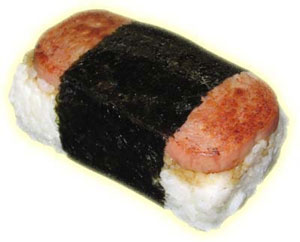| ||
PolynAsian pleasures
by Ari LeVaux If I told you I had Spam sushi for dinner, which country would I be in? Hawaii may not be the sovereign nation many natives still yearn for, but it’s a cultural experience that befits the most isolated island group in the world. Native words are everywhere. So are surfers, whose sport comes from Polynesia, the source of the original Hawaiian culture. While the native Hawaiians (kanaka oiwi in Hawaiian) are ethnically distinct from the Athabascan natives of mainland North America, the relationship between these indigenous Americans and their European settlers represents the most modern such interaction of its kind. In New England, most of the natives were killed or marched off to Western reservations, where they, along with the local Indians, were confined. Fortunately for some Western and northwestern tribes, they were allowed to inhabit areas that coincided with their tribal homelands. In Hawaii, there are no Indian reservations. The haoles (pronounced how-lees), or white settlers, purchased, swindled and otherwise acquired much of the land, inserting themselves – along with their laws, culture and technologies – among the natives, who had no choice but to live side by side with the infiltrators. Though better than reservation life, this arrangement understandably created widespread hostilities, which still rumble beneath the surface like Pele, the hot-tempered Hawaiian goddess of volcano and fire. Most likely, Hawaii was initially populated by Tahitians or Marquez Islanders, who somehow found Hawaii by sailing from distant South Pacific islands – a feat of exploration that rivals any. Then came Captain James Cook, no slouch at the helm either, who along with all sorts of charms brought a cocktail of diseases that reduced the native population to about one-tenth of what it was. By the time the locals figured out that Cook and his men were trouble (and disposed of them accordingly), word of the islands had already gotten out. Outsiders swarmed in, creating things like the world’s largest pineapple plantation, which Jim Dole did on the island of Lanai. Hawaii also boasts the largest cattle ranch in America, the Parker Ranch, currently growing the greenest grass I’ve ever seen. The nearby town of Waimea sports more cowboy boots, belt buckles and rodeos than any American town west of the San Andreas Fault. Along with white settlers, waves of immigrants from all around Asia and the South Pacific arrived, their traditions in tow. For the last hundred years, Hawaiian culture has evolved this way, as a mix of Asian, Polynesian and haole. Not surprisingly, this intermingling of cultures has created some amazing opportunities to grub on. Poke, for example, or Hawaiian sashimi, consists of chunks of raw fish tossed in various mixtures of spicy mayo, seaweed, sesame oil, scallions and flying fish roe. You can get octopus poke, kim chi shrimp or mussel poke. You can get poke in like 10 different flavors at Safeway. Our meal at the Kava bar in Kailua began with its namesake South Pacific drink, which tastes like bitter mud and supposedly gets you high. Even after my mouth went numb it still tasted terrible, though drinking kava while eating fresh pineapple chunks was less disgusting. Then came a plate of “local-style” fish flanked by taro root in coconut sauce, stir-fried veggies and poi, a slightly bitter soup made from pounded and fermented taro and used as a sauce. The side dishes offered great support to the main event, the ahi tuna that I’m writing home about. Rubbed in “brown” (or toasted) sesame oil, garlic, salt and pepper, it was pan fried, with oyster sauce added at the very end. This fusion of East, West and South Pacific was some truly ono grinds and left me whimpering for more. Then we flew to Kauai, the so-called Garden Island and home to the wettest spot on Earth, Mt. Waialeale, which receives an average 460 inches of rain per year. Our plane was late, and the hotels and rental car places were closed. We pitched our camo tent in a grove of feral chicken-infested trees near the airport and hitched a ride to the 7-Eleven, the only place open in Lihue. There was sushi in the cooler: California rolls, vegetable futomaki rolls, and more. And then, under the heat lamp alongside the corn dogs and burritos, I spotted the all-time quintessential epitome of East meets West: musubi. To call it Spam sushi would be nearly correct – except the rice has salt instead of vinegar. Nonetheless, it looks like a big piece of nigiri sushi, wrapped in a strip of seaweed – but with Spam on top instead of raw fish. Taking one for the team, I wolfed down a piece of Spam sushi, as well as a veggie futomaki, and chased it with a can of Dole pineapple chunks – imported from Thailand! It’s funny that of all Western culinary traditions for the Hawaiians to have latched onto, Spam ranks so high. It reminded me of the time years ago in the temperate rainforest of Canada’s northwest coast when I spent five days on boat patrol with a team of Haida Indian rangers in the Kitlope wilderness. We stopped for lunch at one of their family’s fishing camp, where everyone was arm-deep in salmon, which lay in scattered piles on cutting boards and in the smokehouse. “Oh boy,” I thought. We were served what they called “Indian steak,” which was Spam on Wonder bread. It was OK, but I really wanted salmon. At least in Hawaii, where the freshest fish comes wrapped with a little green piece of plastic grass to indicate sushi-grade, I have a choice. •
|


